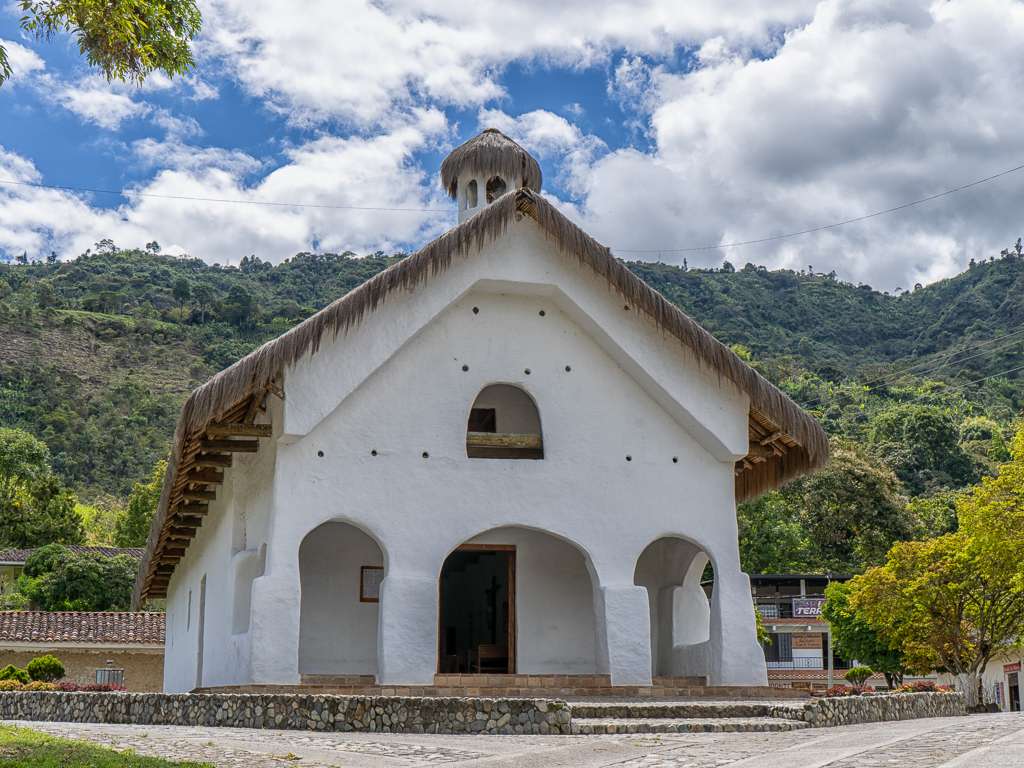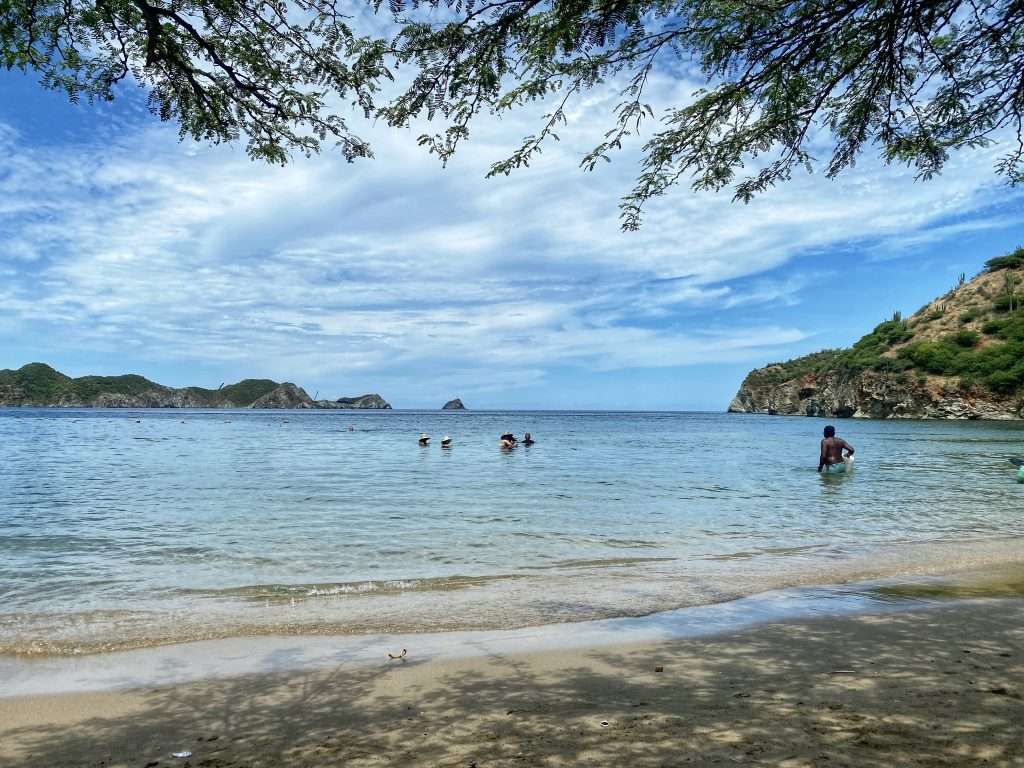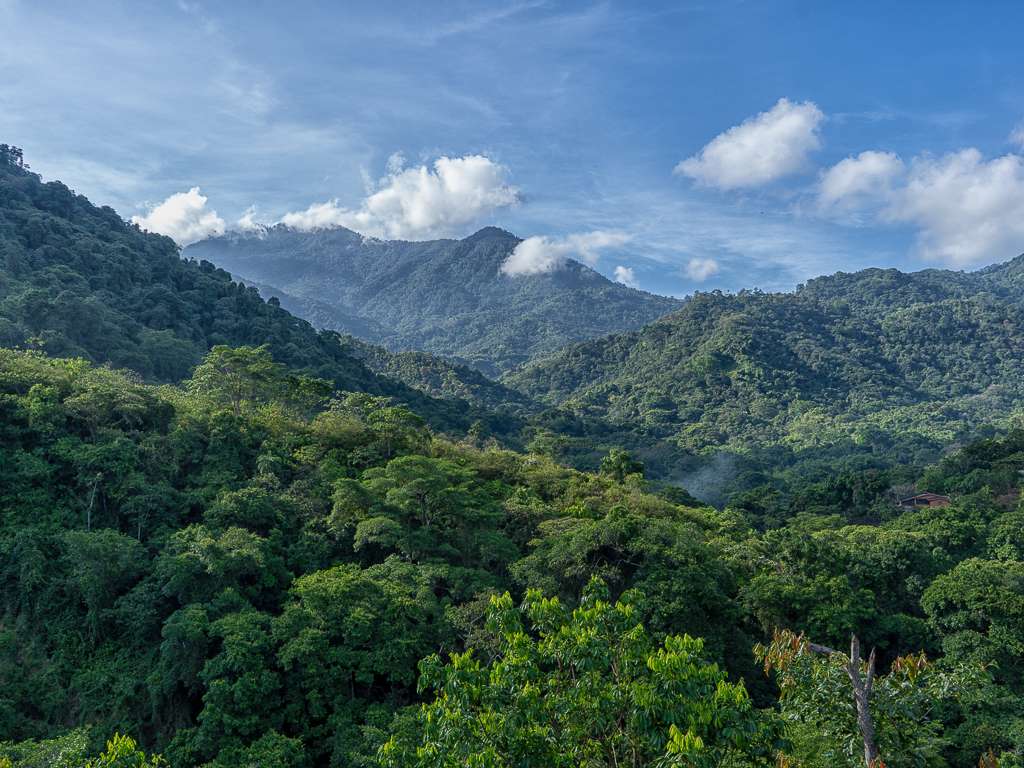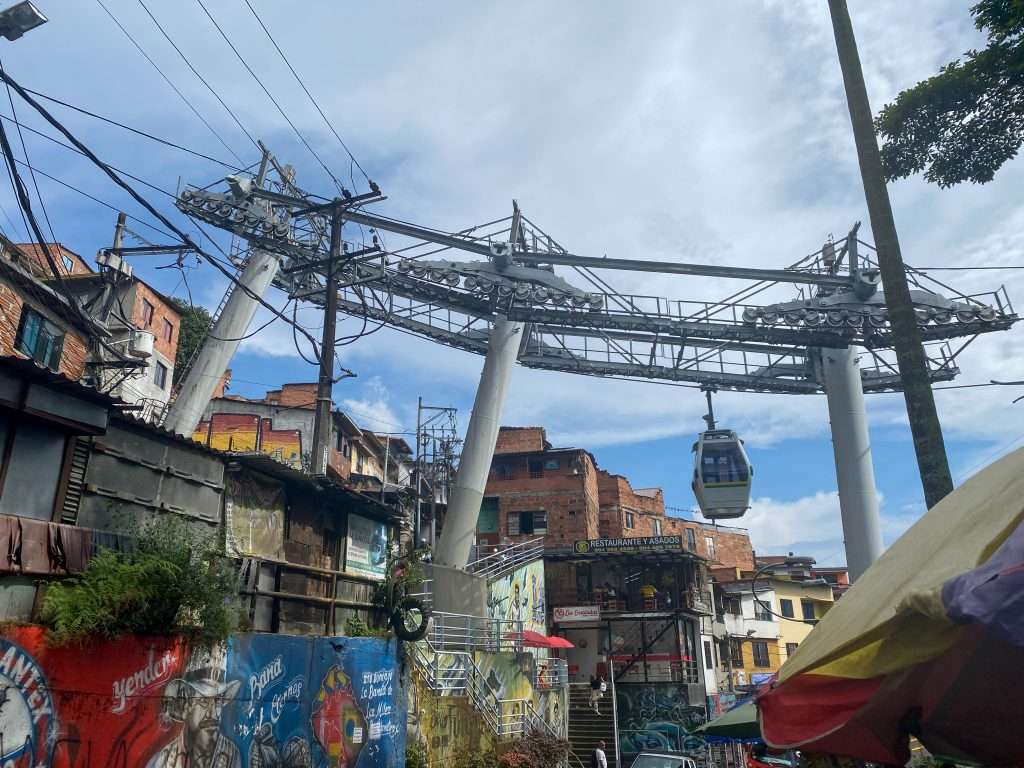
Hike the ancient tombs of Tierradentro | San Andrés de Pisimbalá
To visit Tierradentro you need to head to the tiny pueblo of San Andrés de Pisimbalá. It’s about a 4 hour bus ride, from Popayan
We visited Santa Marta after our short stay in Bogota. So we put together our Santa Marta the top 5 best things to see and do. Santa Marta is a lively and hectic city on the northern coast of Colombia in the area of Magdalena. It was the first place the Spanish settled when they came to South America.
Whilst Santa Marta is a vibrant town in itself with all the charm of a busy commercial centre it really is the gateway to the rest of the area and a great place to base yourselves if you want to visit Tayrona National Park, Minca, the nearby beach of Taganga or the gorgeous mountains of the Sierra Nevada.
It’s also the main starting point for the Lost City Trek which is one of the most popular treks in Colombia. It has a vibrant bar and restaurant culture and many many good accomodation choices.

After spending a few days in Colombia’s capital, Bogota, we headed off to the airport for a morning flight to Santa Marta on Viva Air. The flight was really quick and a good experience all round. We booked the flight on their online website and the process was fairly easy. Once we arrived at Santa Marta and got through the arrivals gate we headed outside in the hope of finding the local bus the would take us to the centre of town.
Just across the road from the airport doors there was a small blue bus, which was the public bus. This is the cheapest and probably the easiest way to get from the airport into town. COP2000 each which is about £0.40p. The other options are a taxi which, like all taxi’s in Colombia, are best pre-booked. Book it from the desk inside the airport rather than flagging one down. The ride on the bus into town took about 30 mins so not long at all really.
There are oodles of options for accommodation in Santa Marta from 5 star hotels to very basic hostels. As we were using Santa Marta for a base to visit other places in the region, we stayed in a couple of different hostels. One we would stay in again and one we didn’t like at all so make sure you check the reviews closely so that you’re not disappointed. As we were on the coast quite a few of the hostels have pools and most offer free breakfast.
The temperature was quite high when we were there in May 2022 so if you can stretch your budget a bit then opt for air conditioning, you won’t regret it. Hostels around the Calle 12 – Calle 18 area means you will be right in the centre and next to all the amenities, attractions, restaurants and bars.
The first hostel we sayed in when we first arrived in Santa Marta was Cacao Hostel. We chose this as it was fairly central, we had a private room with bathroom. The hostel had a pool and was within our budget which was great. To be honest it was fine. The staff were really friendly. The pool was nice, the room was ok. They had a small kitchen where you could order burgers, club sandwiches and pasta and a small bar. This was a good little hostel for the money.
Our next hostel, after our trip to Minca, was Imagine Hostel and this is our favourite in Santa Marta. It had a cool, funky vibe and the staff were lovely. We had a private room with private bathroom and the bedroom was split level with a mezzanine. There wasn’t anything we would fault here apart from the wifi being a bit weak but we’d definitely stay here again.
Finally after our lost city trek we chose The Puerta Azur hostel as the Imagine Hostel didn’t have any availability. This place wasn’t great and not somewhere we’d return to. There were things that didn’t work in the room such as plug sockets and the room we ended up with was a bit grubby. So as I mentioned above, check those reviews!!!

In the centre of town you’ll find the Museo del Oro and Casa Aduana which is a really interesting museum and one of the best things we did in Santa Marta. On the ground floor the Gold Museum has some great exhibits, not only detailing the history of gold and copper in the region, but if you go upstairs you’ll find the story of Santa Marta.
The story describes the time from the town’s beginning when the Spanish settled on mainland Colombia, to the present day. It tells of the main industries of the region and how the indigenous people still carry on with their cultures amidst a large and busy city.
Like the Gold Museum in Bogota the descriptions of the exhibits and the stories are both in English and Spanish so its easy to understand what you’re looking at. You’ll find the museum on Carrera 2 next to Parque Simon Bolivar. Its free to get in and open 9am – 5pm most days but closed on a Monday. There are some other buildings around the Centro Historico region.
Santa Marta is a port city and the large seafront is bordered by the port at one end and the harbour at the other end. Its lovely to walk along the promenade from one end to the other. There is a small beach here but its advised not to take a dip in this area as the water is pretty polluted.
This is an iconic cathedral in Santa Marta and is the resting place of Simon Bolivar. Nestled in the centre of the city, it’s one of the most photographed buildings in Santa Marta. Its a stucco white building which looks amazing in the sunshine and has a bell tower and the interior is lined with religious art pieces.
This building stakes a claim as the oldest church in South America but if you speak to some of the locals there is a small chapel in Taganga which also makes this claim. Why don’t you visit both and then you can decide.

This area is the lively hub of Santa Marta with state monuments and park benches, the area is surrounded by bars and restaurants offering all sorts of food from typical Colombian fare; Mexican, French, Italian and loads of bars with happy hour deals. This place really comes alive after 7pm when all the restaurants open and music flows down the street and the restaurant staff encourage you to eat in their establishments.
Its a fun happy place and you cant help get caught up in the buzz and vibe of the area. We ate a few times in this area, a couple of times in a Mexican restaurant which was simple Mexican food such as nachos, tacos & burritos and the prices were great. We also ate at an italian type restaurant where the pizza was really good. One thing to remember is portions are big so Chris and I always have to remember to share the larger plates.
Parque de los Novios is also the starting point for many of the city’s walking/cycling/food tours. You can usually find information on the free tours in your hostel and they show a what app number to contact the guide however if you’ve not pre-booked then you can just look out for the yellow umbrella at 9.30am or 4.30pm and if there’s a place free you can joint a tour.
If you’re looking for a relaxing day on the beach then you need to head out of the city and take a short bus journey north to the little town of Taganga. Here there are a number of beaches to choose from and the largest of these, Playa Grande has chairs for rent, watersports, beach restaurants and bars but first let met tell you how we got there.
The easiest and cheapest way is by bus and you catch this on on Calle 5, which is the Main Street in Santa Marta and this bus takes you direct to Taganga. If you check on the signs at the bus stop and make sure that the stop shows Taganga then you’re good to go. The buses run at approx 15 mins and cost COP2000 per person which is about £0.40p. Just jump on the bus and pay the driver.
The bus route goes through the town of Taganga but wait till you get to the turning circle down by the fishermen’s boats before getting off. This is the best stop and where you’ll get the bus back to Santa Marta. You can also take a taxi from Santa Marta but I’ve no idea of the cost of this as this isn’t something we did but if you want then your hostel can arrange this for you. Another way is to take a boat from Santa Marta round the coastline to Taganga.
We saw many people arriving at the beach on boats from Santa Marta so this seems a popular way to arrive however on days when its windy then the trip can be quite rough. No idea of the cost of this one as we caught the bus. When you’re returning to Santa Marta by bus then make sure that the bus is going to Santa Marta Centro to get you back to where you started. Some buses go to the port and some go to the Mercado area but the Centro bus is the one that will get you back to the centre.
With the sea in front of you, you head off to your right and follow a path up and round the headland. You’ll pass a path down to the first beach but carry on and after about 10 – 15 mins the path will take you down to Playa Grande which is where all the activities are. The path round the headland is pretty straightforward and easy to navigate and you get some spectacular views back to the bay of Taganga.
You can rent a chair for around COP6000 for the day but try and find one that is shaded by the few trees that run along the waters edge. When the sun gets high there isn’t much shade here on this beach and you’ll be thankful for some shade. There are watersports available to hire; paddle boards, banana rides, kayaks, pedalos all available either for the day or just an hour or so. The beach had the usual sellers offering everything from sun glasses to water melon and there was even a guy offering coconut massages. It’s a great place to people watch.
If you haven’t brought a picnic with you then you won’t be stuck here with nothing to eat. There were restaurants all along the beach front offering food, snacks and drinks. We chose the busiest place to have lunch as we thought if its busy then it must be good and we weren’t disappointed.
These restaurants are just a long shed with sand floor and plastic tables and chairs. At the end of the shed there’s a kitchen where some women are cooking up a storm. We ordered seafood rice and it was amazing. One of the best meals we’ve had in Colombia and it even came with a free bowl of soup. Absolutely delicious. This is one of the things we love about traveling is finding hidden gems like this.

Santa Marta is a superb gateway if you’re planning on visiting Minca. We spent 5 days up in the hills of Minca and you can find out all the details of our trip Here. To get to Minca you have a couple of options. You can opt for a taxi which will cost around COP30000 (£6.00) person or you can opt for the Collectivo which is a shuttle bus running at 30 min intervals and costing only COP9000 (£1.80) You can catch the Collectivo on the corner of Calle 12/11 and Carrera 9 – Right by the main meat and fish market of Santa Marta.
Once in Minca you’ll feel like you’ve stepped into another world. Lush green forest, the sound of birds and insects all day and night replacing the busy traffic sounds of Santa Marta. In Minca you have loads of activities to take part in from bird watching trips to diving in to cool waterfall pools. To see the best of Minca hire a scooter for a day and get away from the tourist areas. Get your hiking boots on and enjoy this area.

Like Minca, Santa Marta is one of the key starting points for the Lost City Trek and this is one of the main reasons we wanted to visit this area. The Lost City Trek is one of the best hikes in Colombia and is an all inclusive trek that must be done with a guide. There are many tour operators offering this trek and we chose Turcol which was the first tour operator to be allowed to offer this trek and they came with good reviews and I can tell you we weren’t disappointed.
You can choose either a 4 day or 5 day trek and all accommodation, meals, a local guide and translator are all included in the price of COP1,400,000 (£280.00). The trek is tough however I cant tell you enough how much this trip is so worth it. This is a once in a lifetime experience and our full account of our Lost City Trek will be published soon so watch this space.

We loved Santa Marta and felt much safer than we had in Bogota but you still have to have your wits about you. It’s a busy commercial city with almost everything being sold everywhere you turn. The people are friendly and we loved the balance of the liveliness of the people of Santa Marta going about there day with the peaceful haven of the beach or Minca right on the doorstep. The public transport system is easy to use and if you do get there then try the Limonada at Baldos on Calle 5, its delicious and perfect on a warm humid day. Santa Marta should most definitely be on your travel list if you’re visiting Colombia.
You can compare cheap flights on the Expedia platform or here on the Aviasales website. Both will give you a good idea of how much its going to cost you to get to your chosen destination.
We have always tended to use Booking.com having said that if your on a tight budget another good site to try as a comparison is Hostelworld, If your looking to compare different sites you can do that on Hotellook, we tend to look on here first to make sure we are getting the best deal.
You can book your visits as you go at the entrance to your chosen attraction or site. Or you could use the following links to book in advance or just to find out what your choices are in the area. GetYourGuide and Tiqets are our go to choices you could try Viator to see how they compare.
For a full list check out our resources page. Don’t forget always shop around to find the best deal for you. What works for us should be good for you but it’s always reassuring to check.
Some of the links on this page contain affiliate marketing links, which means we may get paid commission on sales of those products or services we write about. You will never be charged a fee for shopping through one of our affiliate links. You may even get a discounted rate and we will make a small commission. Our editorial content is not influenced by advertisers or affiliate partnerships.

To visit Tierradentro you need to head to the tiny pueblo of San Andrés de Pisimbalá. It’s about a 4 hour bus ride, from Popayan

We arrived into popayan the weekend of the Colombian presidential elections. The streets were unnaturally quiet with the anticipation that something monumental may happen.

In this blog we will describe for you five amazing things to discover in the Colombian city of Medellin. Once notorious as being the murder capital of the world the new improved cleaned up Medellin is a delight to explore.
@Andiamo Amigos 2020 – 2022
All rights reserved. Photography and written content may not be reproduced without our permission.
| Cookie | Duration | Description |
|---|---|---|
| cookielawinfo-checkbox-analytics | 11 months | This cookie is set by GDPR Cookie Consent plugin. The cookie is used to store the user consent for the cookies in the category "Analytics". |
| cookielawinfo-checkbox-functional | 11 months | The cookie is set by GDPR cookie consent to record the user consent for the cookies in the category "Functional". |
| cookielawinfo-checkbox-necessary | 11 months | This cookie is set by GDPR Cookie Consent plugin. The cookies is used to store the user consent for the cookies in the category "Necessary". |
| cookielawinfo-checkbox-others | 11 months | This cookie is set by GDPR Cookie Consent plugin. The cookie is used to store the user consent for the cookies in the category "Other. |
| cookielawinfo-checkbox-performance | 11 months | This cookie is set by GDPR Cookie Consent plugin. The cookie is used to store the user consent for the cookies in the category "Performance". |
| viewed_cookie_policy | 11 months | The cookie is set by the GDPR Cookie Consent plugin and is used to store whether or not user has consented to the use of cookies. It does not store any personal data. |